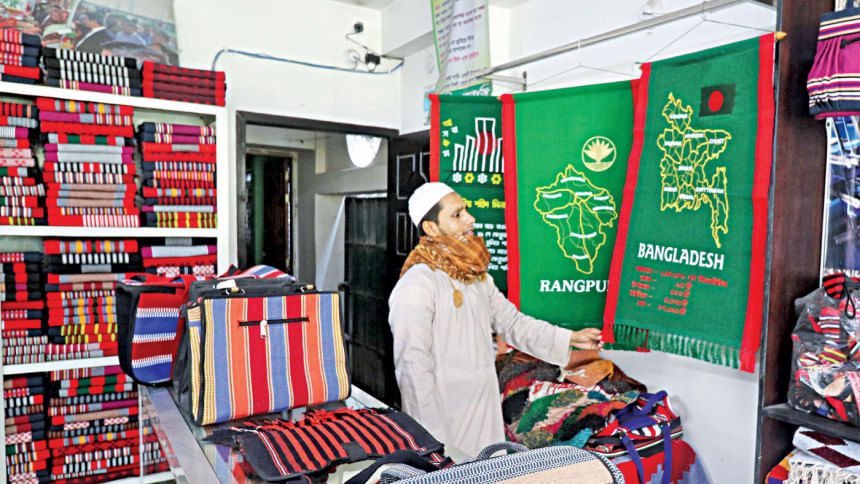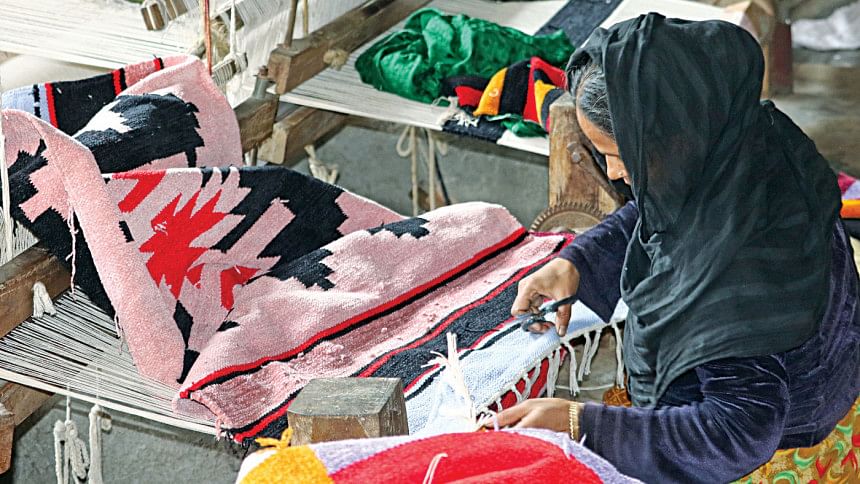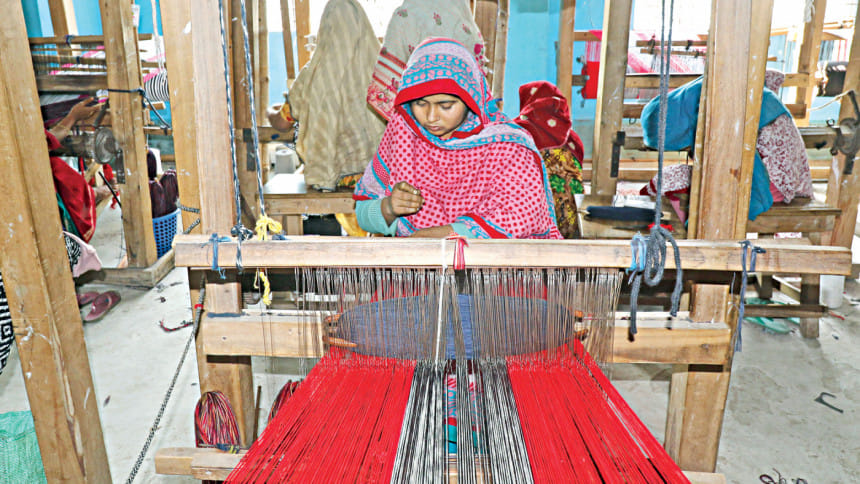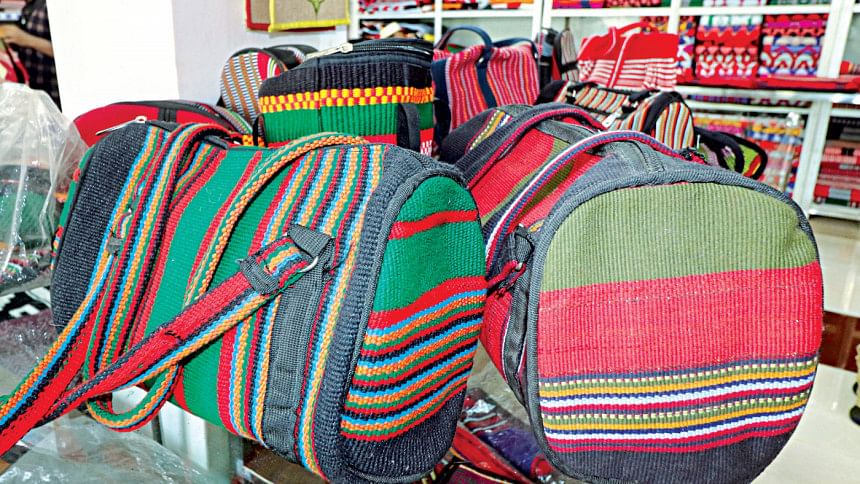Rangpur’s shatranji industry near the end of its rope

The shatranji industry in Rangpur is struggling to survive as demand from home and abroad for the sitting mats made by handloom has diminished amid the ongoing coronavirus pandemic, according to local traders.
Besides, the increasing price of raw materials has made it difficult for producers to continue operations, they said.
Shatranji also comes in the form of rugs, placemats and carpets.
Around 50,000 people of Rangpur are involved in the making of shatranji products, 95 per cent of whom are women.

Historians say that prior to 1830, shatranji was weaved solely in Pirpur village of Rangpur's sadar upazila.
The carpets and tapestries were used as home decor by wealthy families.
As per the Bengal District Gazetteer published in 1912, author WW Hunter writes that Nisbet, the district collector of Rangpur at the time, was so mesmerised by the unique product that he volunteered to be the lead patron of the local shatranji weaving artisans in 1880.
To commemorate his support to the industry, locals renamed Pirpur as Nisbetganj, which is just 5 kilometres away from the Rangpur district headquarters.
Shatranji sales flourished during the British era, when it was shipped to various destinations including India, Sri Lanka, Indonesia, Thailand and Malaysia.
It is believed by locals that shataranji has been crafted in the region ever since the Mughal era.
However, the industry fell into crisis soon after the partition of India, when the influx of modern machine-made products forced many artisans to switch to other professions in search of better incomes.
As a result, the industry shrunk to a very small scale in Rangpur.

Besides, financial constraints and unplanned marketing made things more difficult, locals said.
As a result, the industry which once had great potential was on the verge of extinction but despite this crisis, shatranji artists have been creating the product in their own way for a long time.
Things started changing from the 70s though, they added.
Over the years, many shatranji factories have been built in Nisbetganj village in a bid to retain the unique handicraft business but things became more challenging as demand decreased while raw material costs rose.
Garment waste, such as leftover cotton, is used as a raw material to craft shatranji, local traders said.
Md Masuder Rahman, managing director of the Charushy Shataranji & Crafts in Rangpur, said shatranji weaving was once limited to Nisbetganj village but over the years, it expanded to other upazilas, including Pirgachha and Pirganj.
Besides, a small group of women in four districts of Rangpur region -- Gaibandha, Kurigram, Lalmonirhat and Nilphamari -- were trained as entrepreneurs in this sector.
Around 150 women work at his factory, Rahman said.

A number of other entrepreneurs in the district said online platforms could be the solution to marketing shatranji.
"A platform that can link traders with buyers could solve the marketing problem," said Mostafizar Rahman, an entrepreneur in Rangpur.
While speaking to The Daily Star on Sunday, Charushy Managing Director Rahman said his factory in Nisbetganj village has been in operation for the last 15 years with 150 handlooms.
"But the diminishing demand for shatranji is making the businesses more troubling," he said.
"And since it is not possible for the industry to survive on just local demand, we want more access to international markets," Rahman added.
The managing director also urged the government to help revive the industry.
Meanwhile, the price of raw materials used to craft shatranji has doubled over the past two years and if this trend continues, then the product price will also increase.
"But if we do that then customers might be further discouraged," Rahman said.
During a recent visit to Nisbetganj, this correspondent found various types of shatranji products, including floor mats, tapestries and carpets, on display.
These days, even handbags are being made in this style at an affordable cost.
Apart from in factories, many women in the area weave shatranji products at home.
Azmira Khatun of Nisbetganj village has been involved in the industry for the last 10 years.
She needs at least three days to weave a 4 by 2.5 feet shatranji product, for which she gets paid Tk 145.
"It is quite hard for me to earn Tk 2,000 per month from the business as I craft in-between chores," Khatun said, adding that since other professions pay better, many women were leaving the industry.
Aysha Khatun, a 60-year-old woman of the same village, said she has been weaving shatranji since coming to Nisbetganj village after her marriage in the late 80s.

"But my wages have never been enough, making it hard to stay in such a laborious profession," she said.
If the wage is insufficient, women will not be interested in such a profession, Khatun added.
Women can easily enter the profession attending a two-month training course organised by the Bangladesh Small and Cottage Industries Corporation (BSCIC).
The BSCIC arranges training to develop the skills of a large number of women every year. However, no training has been organised amid the ongoing pandemic.
Faruk Hossain, a trainer of the BSCIC office in Rangpur, said at least 600 people, mostly women, were trained in weaving shatranji in the last three years.
However, the project remains suspended at the moment, he added.
Mostafa Azad Chowdhury Titu, president of the Chamber of Commerce and Industry in Rangpur, said access to finance was another major problem for small scale investors in the industry.
So he urged the country's banks to disburse easy loans among the related entrepreneurs, particularly women.
There is huge demand for shatranji products in both local and international markets but many large scale factories, including Karu Ponyo and others, have already lost the markets due to the Covid-19 fallout.
"They are now selling their products offering discounts," Titu said.
There is a big market for shatranji products in different countries of Europe but orders were cancelled amid the current crisis, he added.

 For all latest news, follow The Daily Star's Google News channel.
For all latest news, follow The Daily Star's Google News channel. 



Comments